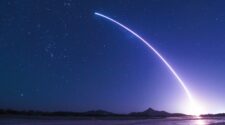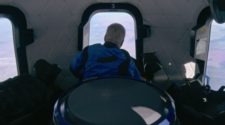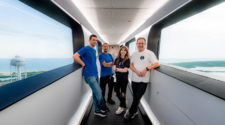For many millenia, all of humanity had been bound to this terrestrial planet we call Earth, but in 1965 our species took its first steps into the unknown of outer space. Russian Alexey Leonov became the first to conduct a spacewalk in March 1965 , followed several months later by American astronaut Edward White in June 1965. From those first early tentative spacewalks, men and women of Earth have accumulated thousands of hours in the vacuum of space, the majority of those hours spent assembling and maintaining the International Space Station.
NASA has released a new video, “Suit Up”, celebrating 50 years of spacewalks, or extravehicular activity (EVA) as they are officially called. The 32-minute long documentary features interviews with NASA Administrator Charles Bolden, a veteran of Space Shuttle flights, NASA Deputy Administrator and spacesuit designer, Dava Newman, as well as a plethora of astronauts, engineers, technicians, managers and luminaries of spacewalk history. They share their personal stories and thoughts that cover the full EVA experience — from the early spacewalking experiences, to spacesuit manufacturing, to modern day spacewalks aboard the International Space Station as well as what the future holds for humans working on a tether in space.
“Suit Up” is narrated by actor and fan of space exploration Jon Cryer. He recently traveled to Star City (Russia), NASA Headquarters (Washington D.C.) and the Johnson Space Center (Houston, Texas) to film “I Explore”, an upcoming Travel Channel documentary series.
50 years of spacewalks gallery
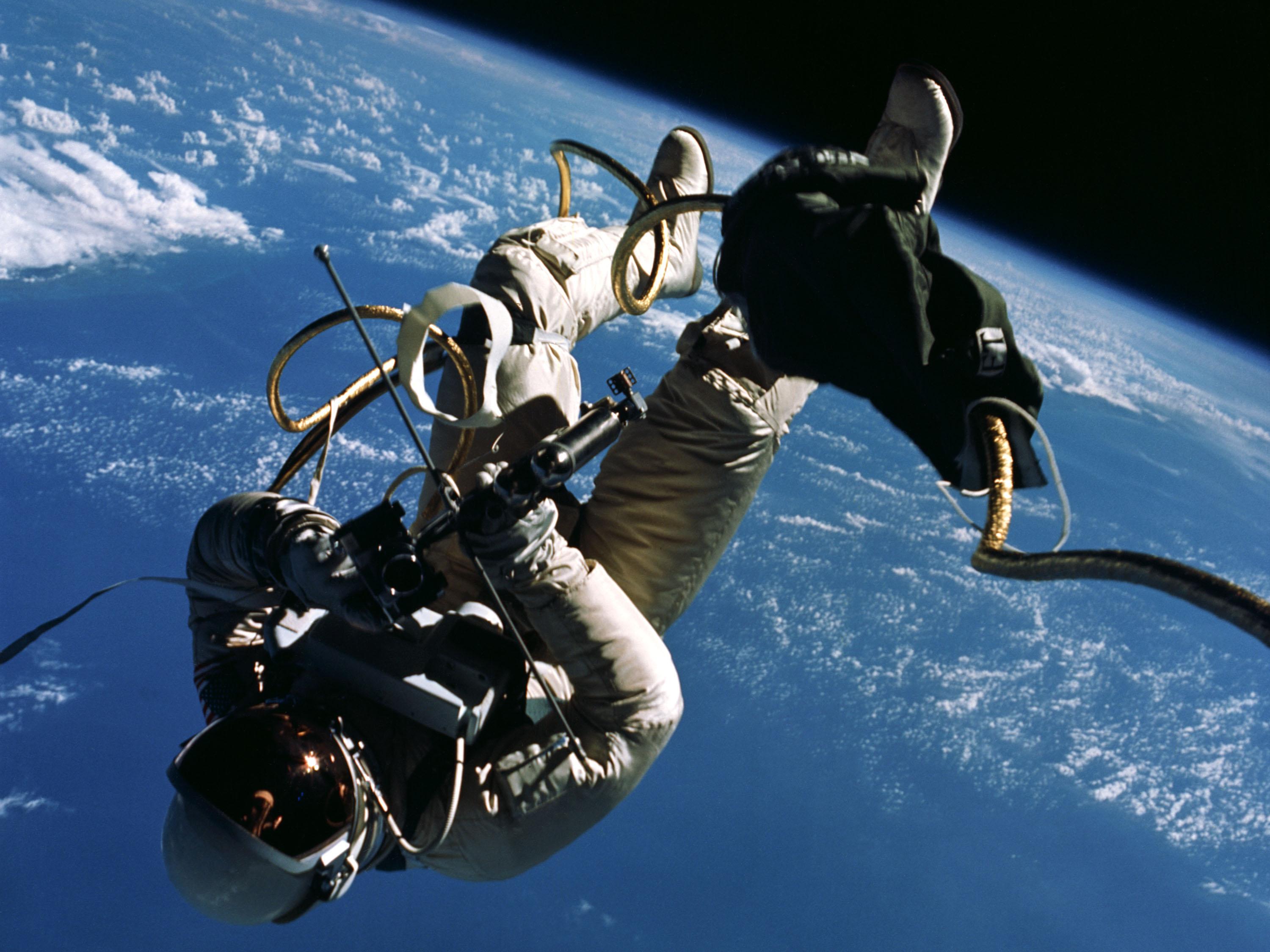
America’s first spacewalk – June 3, 1965
Astronaut Edward H. White II performed the first American spacewalk during the Gemini 4 mission on June 3, 1965. White, pilot of the Gemini IV four-day Earth-orbital mission, floats in the zero gravity of space outside the Gemini IV spacecraft. White wears a specially designed spacesuit; and the visor of the helmet is gold plated to protect him against the unfiltered rays of the sun. He wears an emergency oxygen pack, also. He is secured to the spacecraft by a 25-feet umbilical line and a 23-feet tether line, both wrapped in gold tape to form one cord. In his right hand is a Hand-Held Self-Maneuvering Unit (HHSMU) with which he controls his movements in space. Astronaut James A. McDivitt, command pilot of the mission, remained inside the spacecraft.
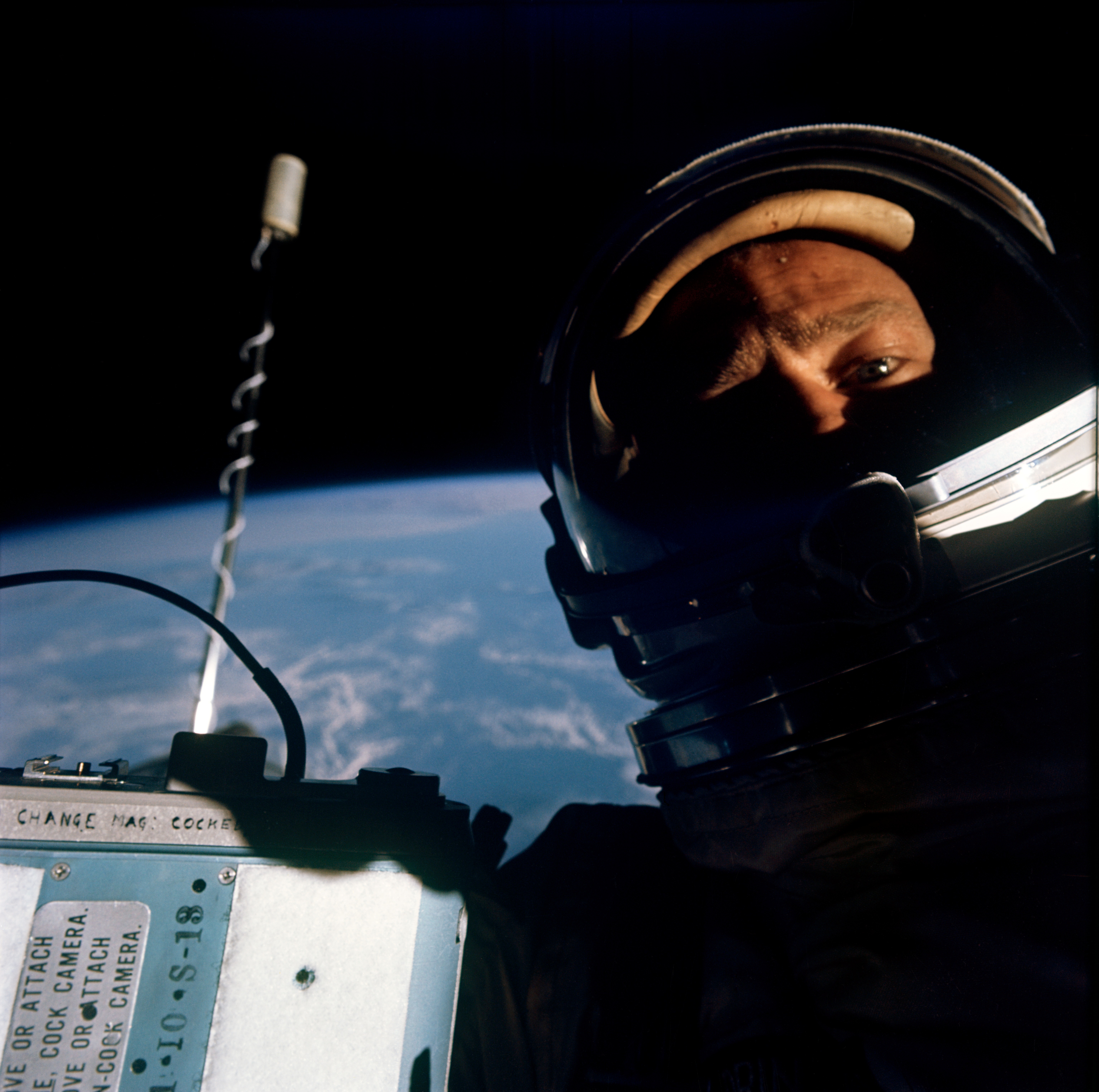
Buzz takes a selfie – November 1966
Commonly referred to now as the first ‘space selfie’, astronaut Edwin E. Aldrin., Jr., pilot of the Gemini-12 spaceflight is photographed with pilot’s hatch of the spacecraft open. Also visible is the J.A. Maurer camera that was used to photograph some of his extravehicular activty. Astronaut James A. Lovell, Jr., was the command pilot of the mission.
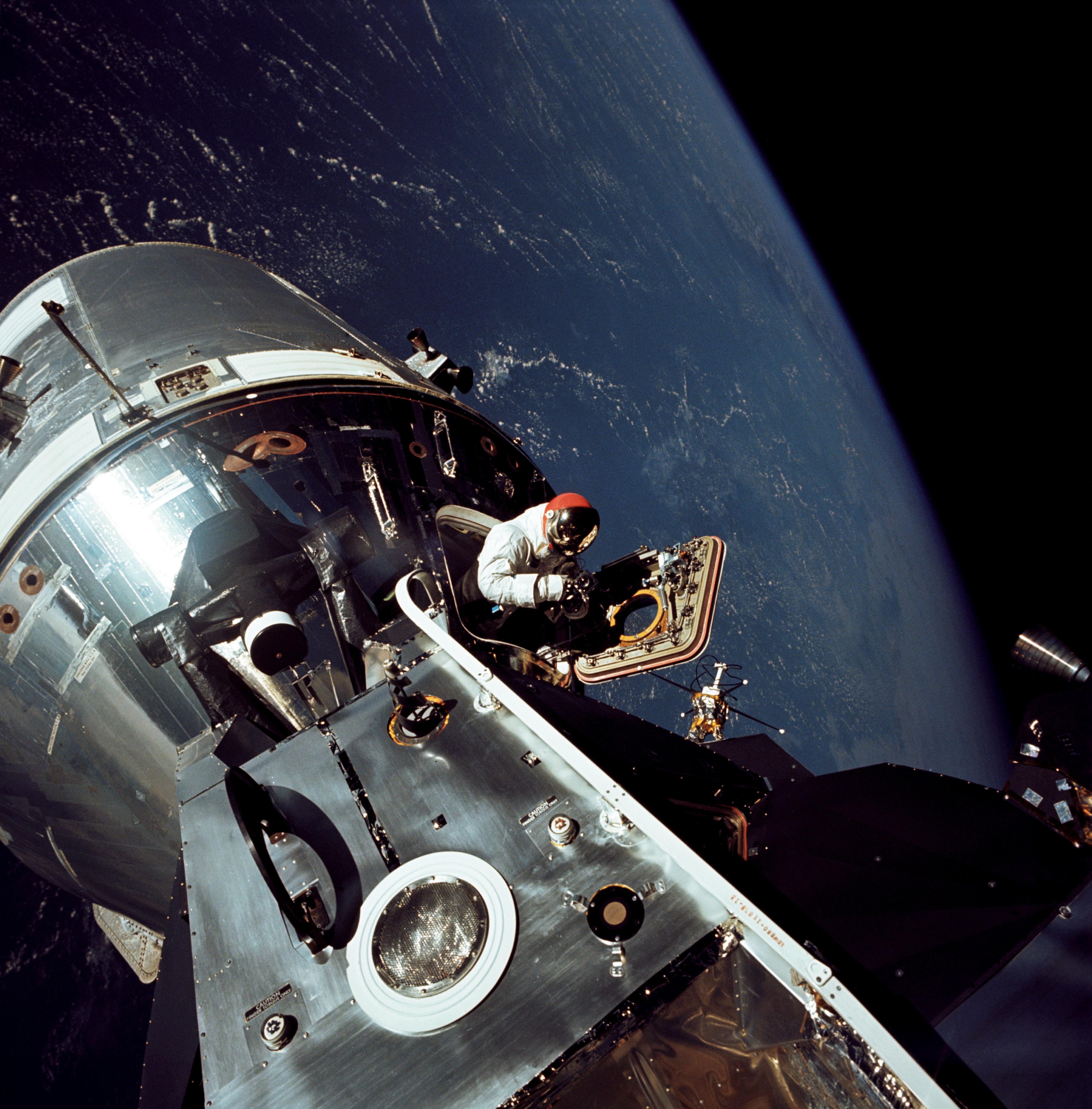
David Scott in the Apollo 9 Command Module – March 1969
The docked Apollo 9 command and service modules and lunar module conduct the first docking maneuvers in space. This image was taken on the fourth day of the Apollo 9 Earth-orbital mission by lunar module pilot Russell L. Schweickart of David Scott, command module pilot, in the open hatch of the command module.
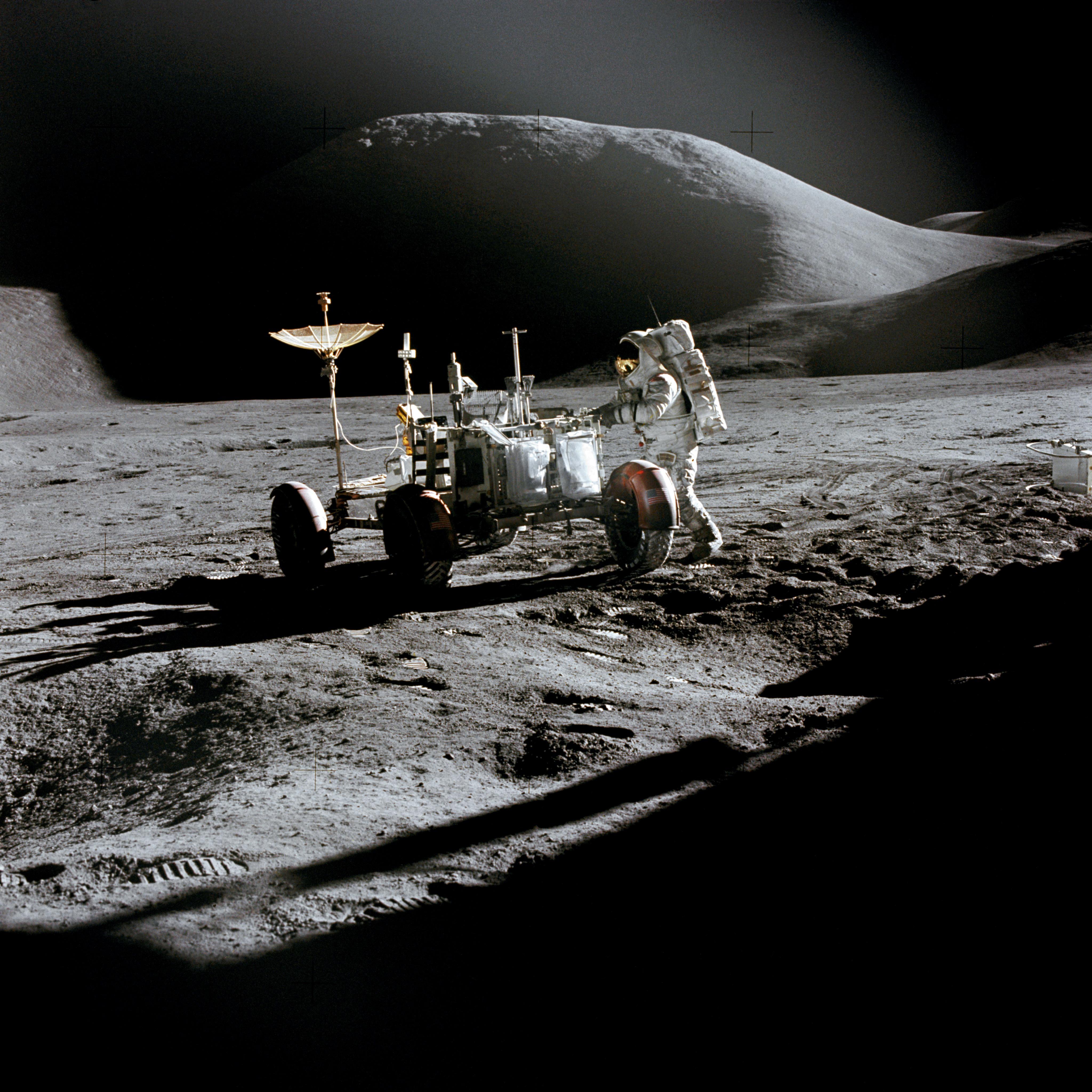
Apollo 15 spacewalk with lunar rover – July 1971
While some might not consider it a spacewalk in the traditional sense, the 10 Moonwalkers were indeed conducting EVAs during their time on the lunar surface. Here, astronaut James B. Irwin, lunar module pilot, works at the Lunar Roving Vehicle during the first Apollo 15 lunar surface extravehicular activity at the Hadley-Apennine landing site. The shadow of the Lunar Module “Falcon” is in the foreground. This view is looking northeast, with Mount Hadley in the background. The photograph was taken by astronaut David R. Scott, commander.
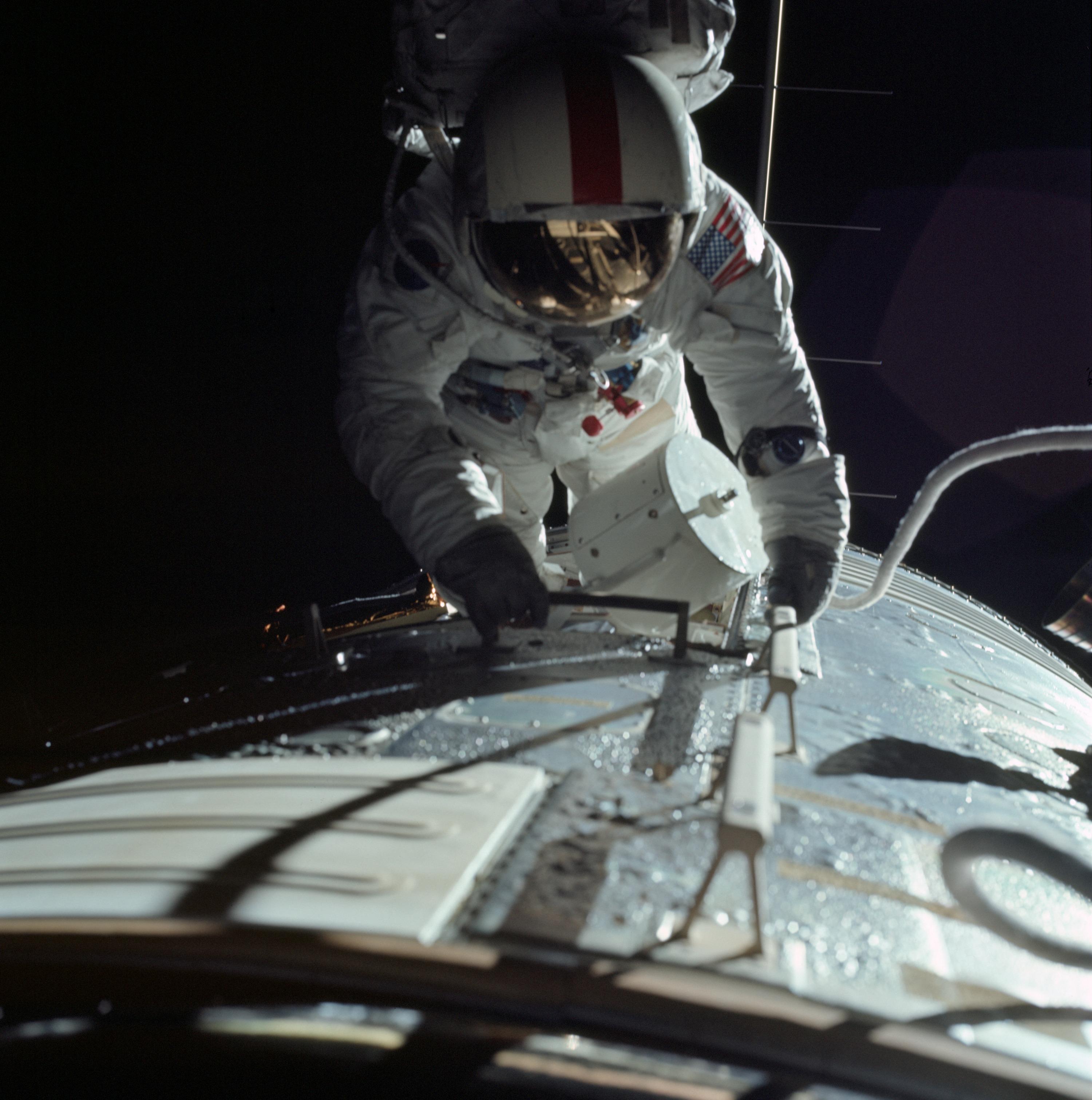
Apollo 17 spacewalk – December 1972
Astronaut Ronald E. Evans, Jr., Apollo 17 command module pilot, is photographed performing a spacewalk during the spacecraft’s trans-Earth coast. During his spacewalk, Evans retrieved film cassettes from the Lunar Sounder, Mapping Camera and Panoramic Camera. The cylindrical object at Evans’ left side is the Mapping Camera cassette. The total time for the trans-Earth spacewalk was 1 hour, 7 minutes, 18 seconds, on Sunday, Dec. 17, 1972.
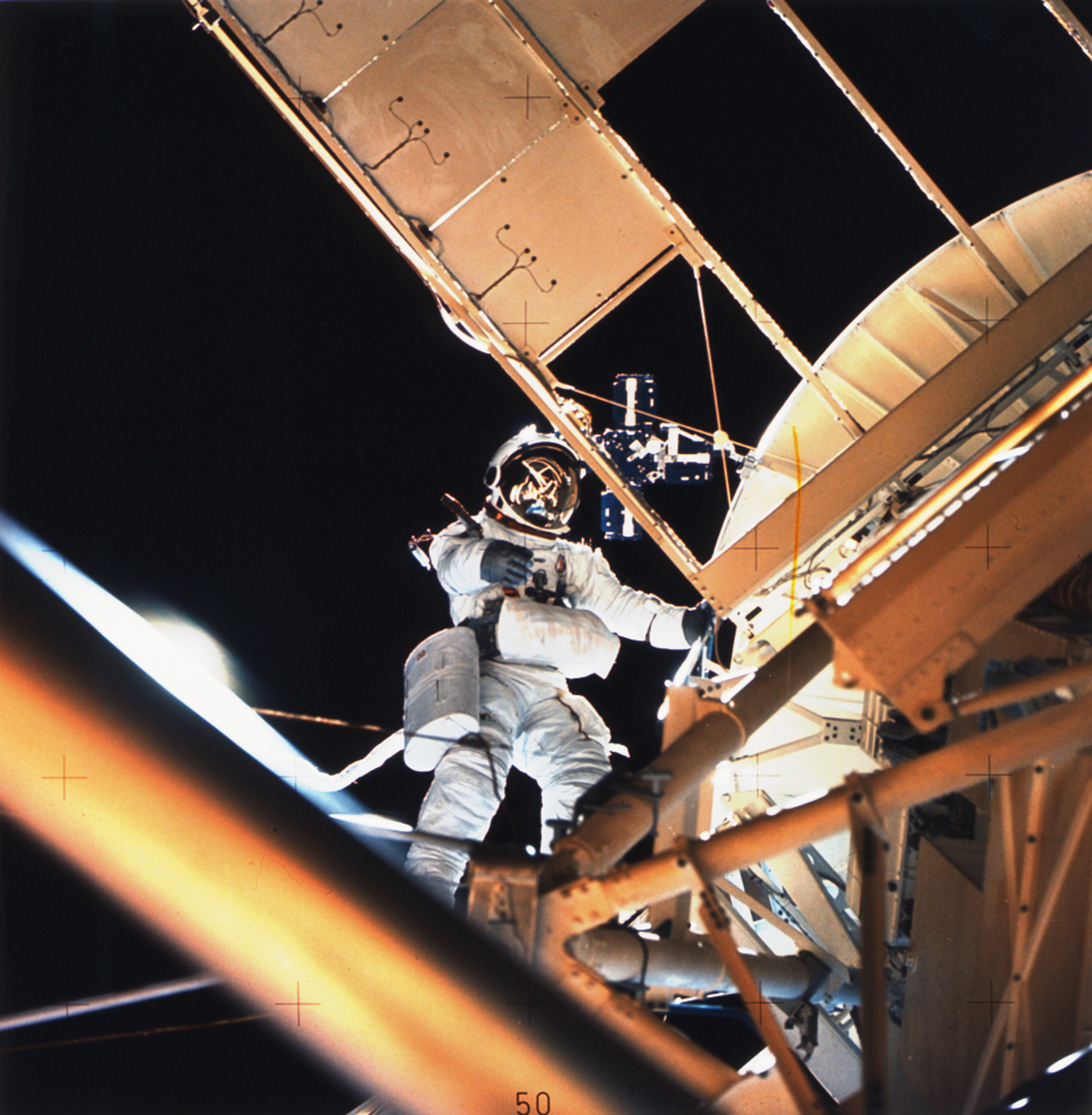
Owen Garriott performs a spacewalk during Skylab 3 mission – August 1973
Astronaut Owen Garriott performs a spacewalk at the Apollo Telescope Mount (ATM) of the Skylab space station cluster in Earth orbit, photographed with a hand-held 70mm Hasselblad camera. Garriott had just deployed the Skylab Particle Collection S149 Experiment. The experiment was mounted on one of the ATM solar panels. The purpose of the S149 experiment was to collect material from interplanetary dust particles on prepared surfaces suitable for studying their impact phenomena. Earlier during the spacewalk, Garriott assisted astronaut Jack Lousma, Skylab 3 pilot, in deploying the twin pole solar shield.
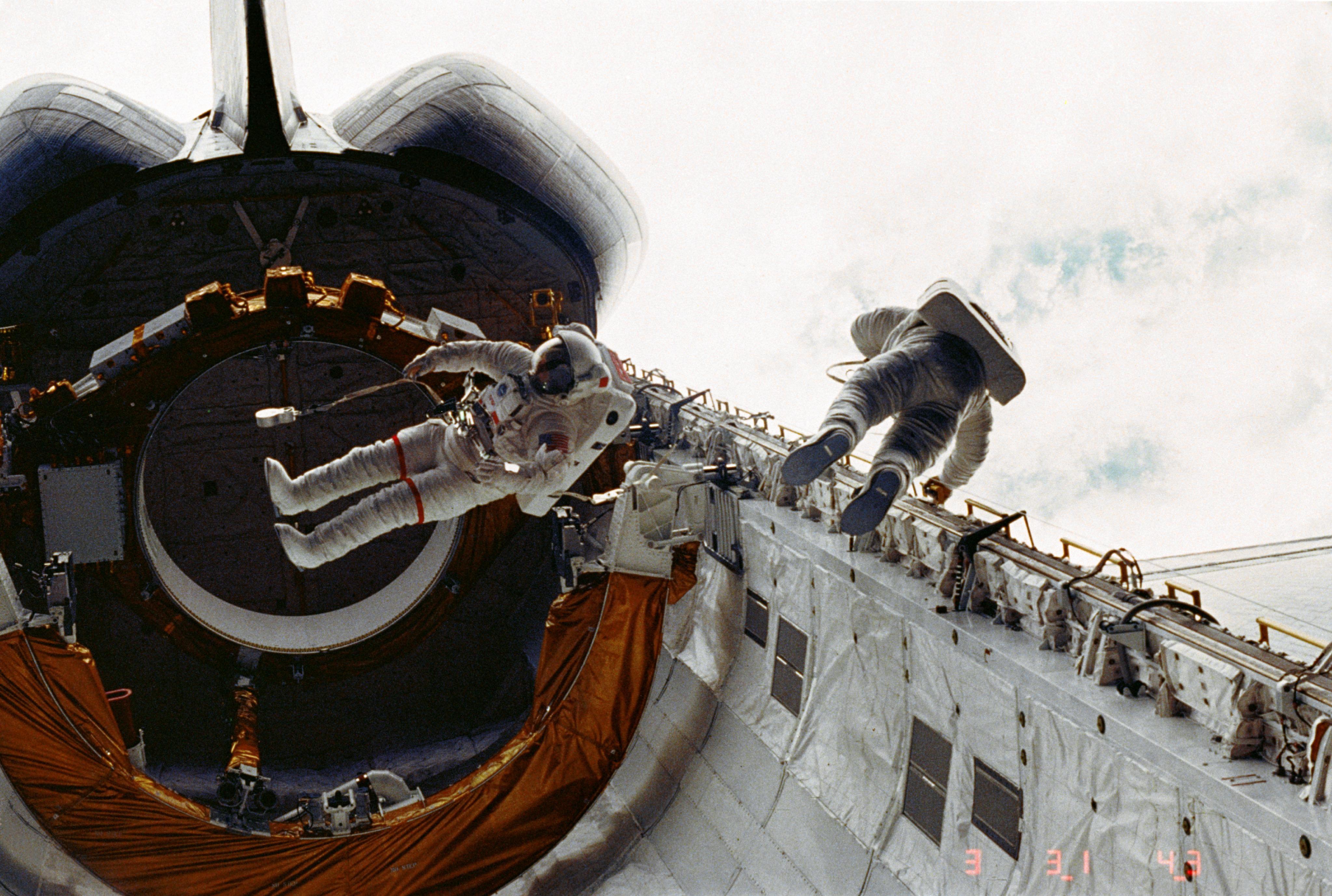
Spacewalk during maiden voyage of Shuttle Challenger – April 1983
Astronauts Story Musgrave, left, and Don Peterson float in the cargo bay of the Earth-orbiting space shuttle Challenger during their April 7, 1983, spacewalk on the STS-6 mission. Their “floating” is restricted via tethers to safety slide wires. Thanks to the tether and slide wire combination, Peterson is able to translate, or move, along the port side hand rails.
First called STA-099, Challenger was built to serve as a test vehicle for the Space Shuttle program. Challenger, the second orbiter to join NASA’s Space Shuttle fleet, arrived at Kennedy Space Center in Florida in July 1982.
Challenger launched on her maiden voyage, STS-6, on April 4, 1983 and saw the first spacewalk of the shuttle program, as well as the deployment of the first satellite-the Tracking and Data Relay System. The orbiter launched the first American woman, Sally Ride, into space on mission STS-7 and was the first to carry two U.S. female astronauts on mission STS-41-G.
The first orbiter to launch and land at night on mission STS-8, Challenger also made the first Space Shuttle landing at Kennedy Space Center, concluding mission STS 41-B. Spacelabs 2 and 3 flew aboard the ship on missions STS 51-F and STS 51-B, as did the first German-dedicated Spacelab on STS 61-A. A host of scientific experiments and satellite deployments were performed during Challenger’s missions.
Challenger’s service to America’s space program ended in tragedy on Jan. 28, 1986. Just 73 seconds into mission STS-51L, a booster failure caused an explosion that resulted in the loss of seven astronauts, as well as the vehicle.
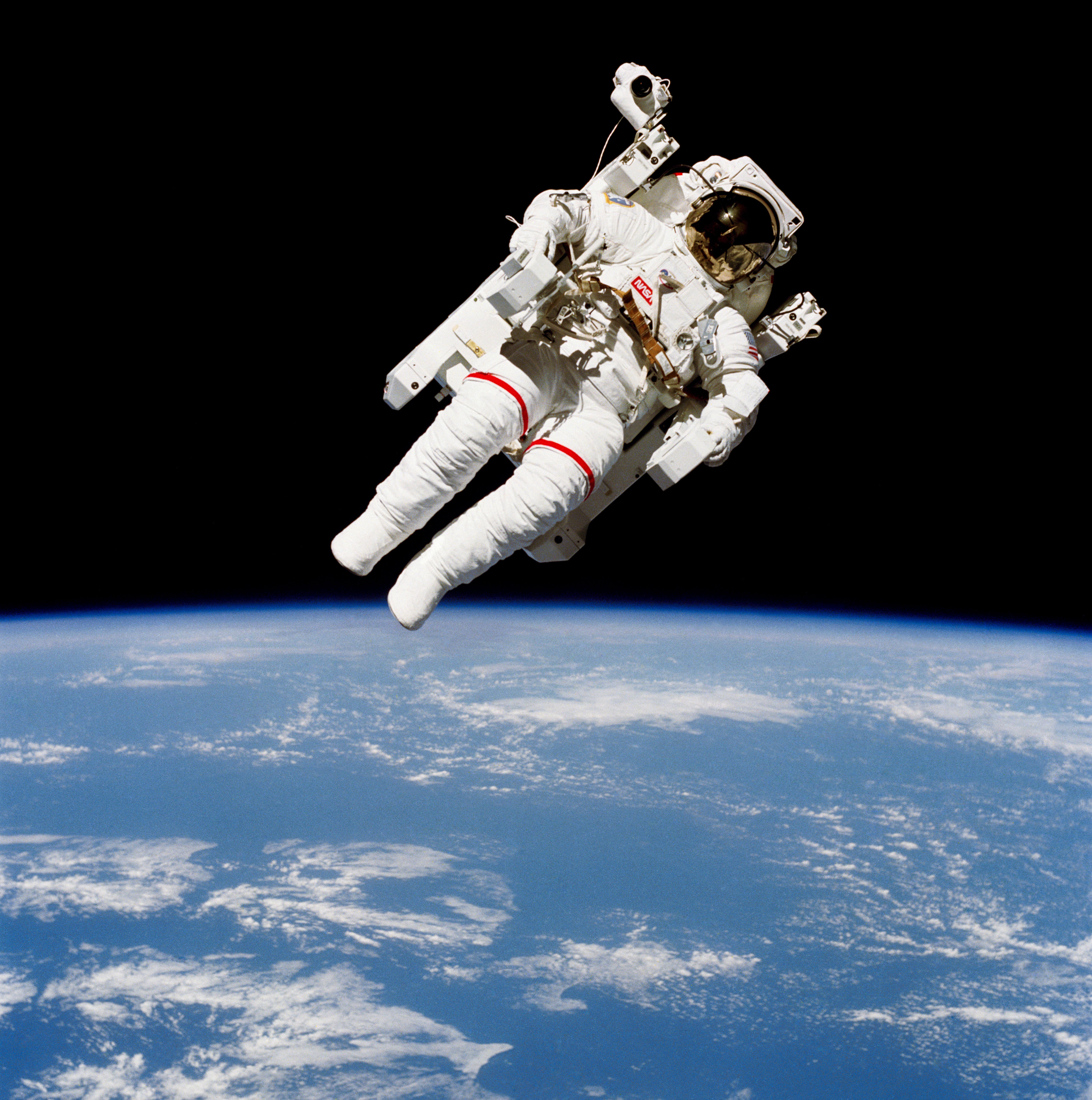
Astronaut Bruce McCandless floating free – February 1984
Astronaut Bruce McCandless II, STS 41-B mission specialist, participates in a historical spacewalk. He is pictured a few meters away from the cabin of the Earth-orbiting Space Shuttle Challenger. This spacewalk represented the first use of a nitrogen-propelled, hand-controlled device called the Manned Maneuvering Unit (MMU), which allows for much greater mobility than that afforded previous space walkers who had to use restrictive tethers.
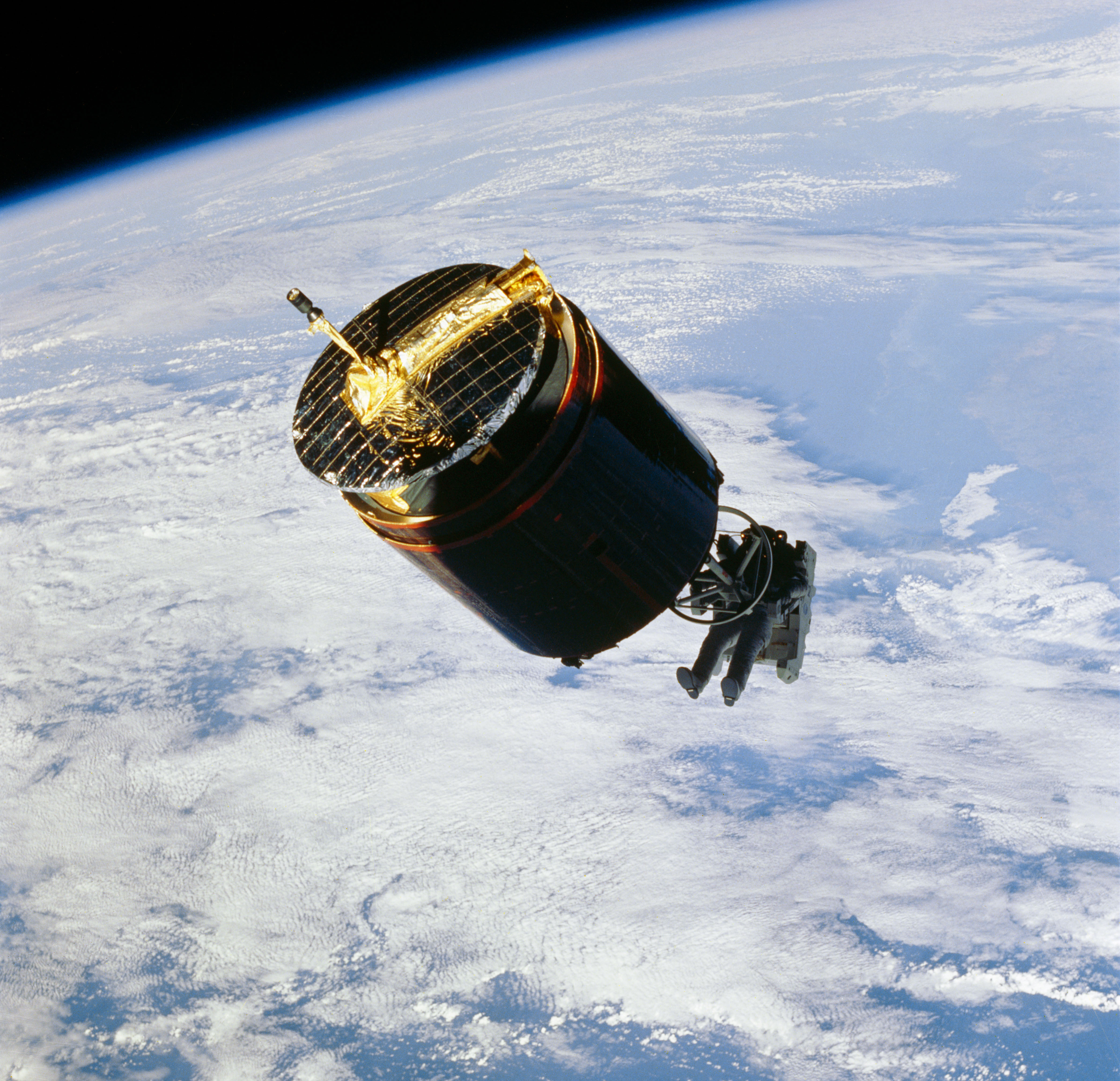
Capturing a satellite – November 1984
Astronaut Dale A. Gardner, getting his turn in the Manned Maneuvering Unit, prepares to dock with the spinning WESTAR VI satellite during the STS-51A mission. Gardner used a large tool called the Apogee Kick Motor Capture Device to enter the nozzle of a spent WESTAR VI engine and stabilize the communications spacecraft sufficiently to capture it for return to Earth in the cargo bay of the space shuttle Discovery.
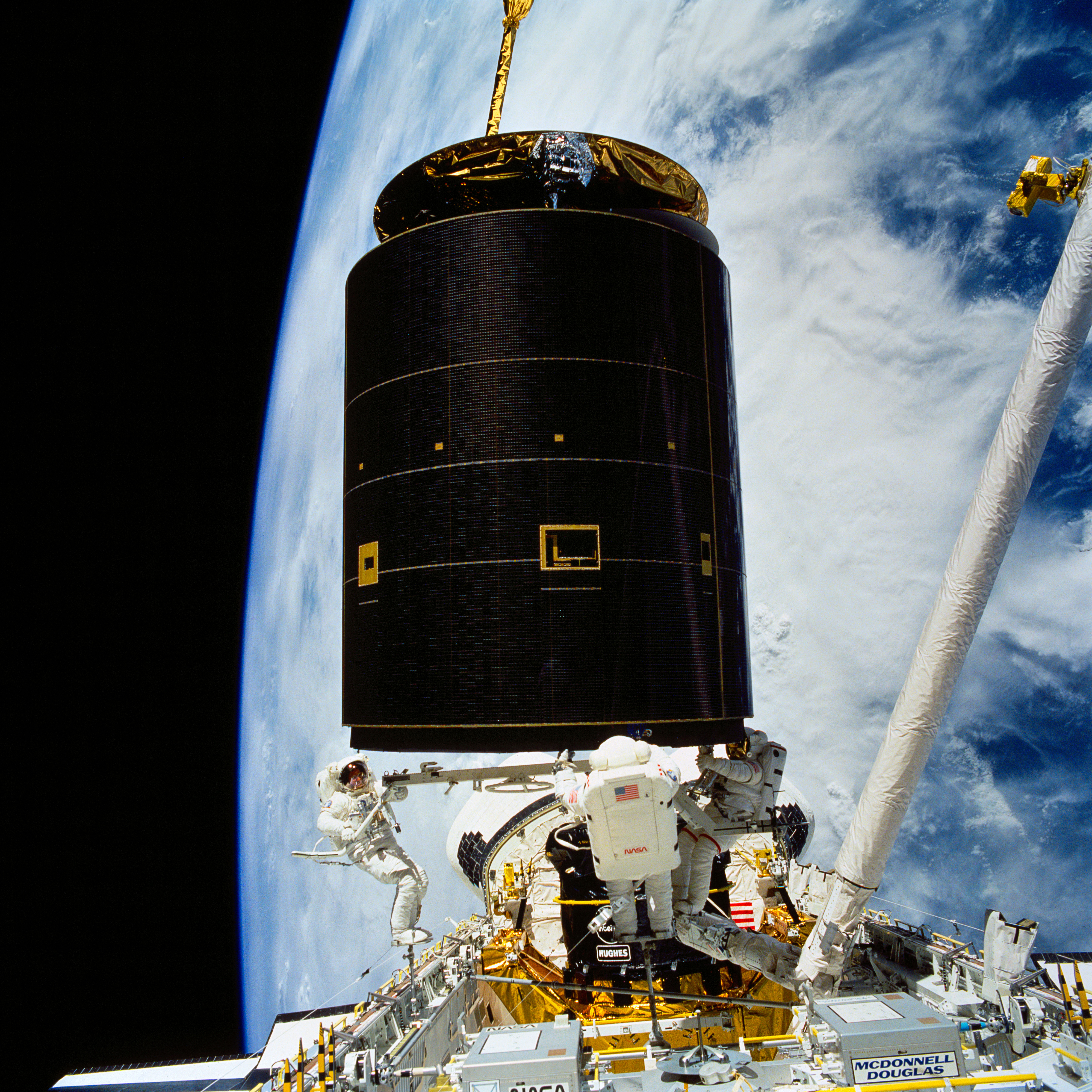
Record-setting spacewalk on Shuttle Endeavour’s first mission – May 1992
On May 13, 1992, following the successful capture of the Intelsat VI satellite, three astronauts continue moving the 4.5 ton communications satellite into the space shuttle Endeavour’s cargo bay. A fellow crew member recorded this 70mm still frame from inside Endeavour’s cabin. Left to right, astronauts Richard J. Hieb, Thomas D. Akers and Pierre J. Thuot, cooperate on the effort to attach a specially designed grapple bar underneath the satellite. Thuot stands on the end of the Remote Manipulator System’s (RMS) arm while Hieb and Akers are on Portable Foot Restraints (PFR) affixed to Endeavour’s portside and the Multipurpose Support Structure (MPESS), respectively. The sections of Earth which form the backdrop for the scene are blanketed with thousands of square miles of clouds.
The Intelsat satellite, stranded in an unusable orbit since its launch aboard a Titan vehicle in March 1990, was equipped with a new perigee kick motor. The satellite was subsequently released into orbit and the new motor fired to put the spacecraft into a geosynchronous orbit for operational use. The capture required three spacewalks: a planned one by astronaut Pierre J. Thuot and Richard J. Hieb who were unable to attach a capture bar to the satellite from a position on the RMS; a second unscheduled but identical attempt the following day; and finally an unscheduled but successful hand capture by Pierre J. Thuot and fellow crewmen Richard J. Hieb and Thomas D. Akers as Commander Daniel C. Brandenstein delicately maneuvered the orbiter to within a few feet of the 4.5 ton communications satellite.
The STS-49 mission, the first flight of shuttle Endeavour, set records for the first (and only, to date) spacewalk involving three astronauts; first shuttle mission to feature four spacewalks; first shuttle mission requiring three rendezvous with an orbiting spacecraft; first attachment of a live rocket motor to an orbiting satellite and first use of a drag chute during a shuttle landing.
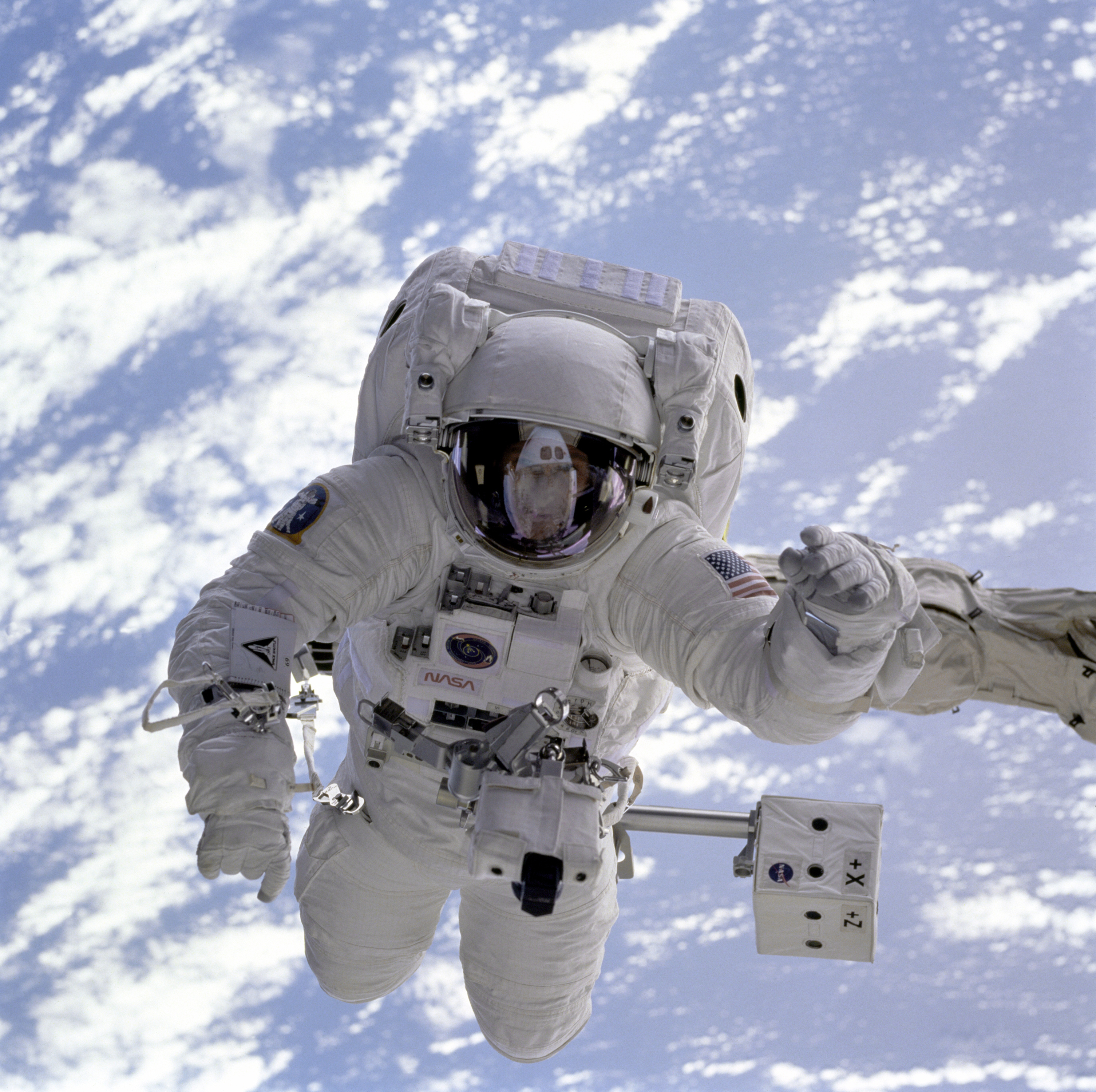
Hanging out on the robotic arm – September 1995
The pale blue Earth serves as a backdrop for astronaut Michael Gernhardt, who is attached to the Shuttle Endeavour’s robot arm during a spacewalk on the STS-69 mission in 1995. Unlike earlier spacewalking astronauts, Gernhardt was able to use an electronic cuff checklist, a prototype developed for the assembly of the International Space Station.
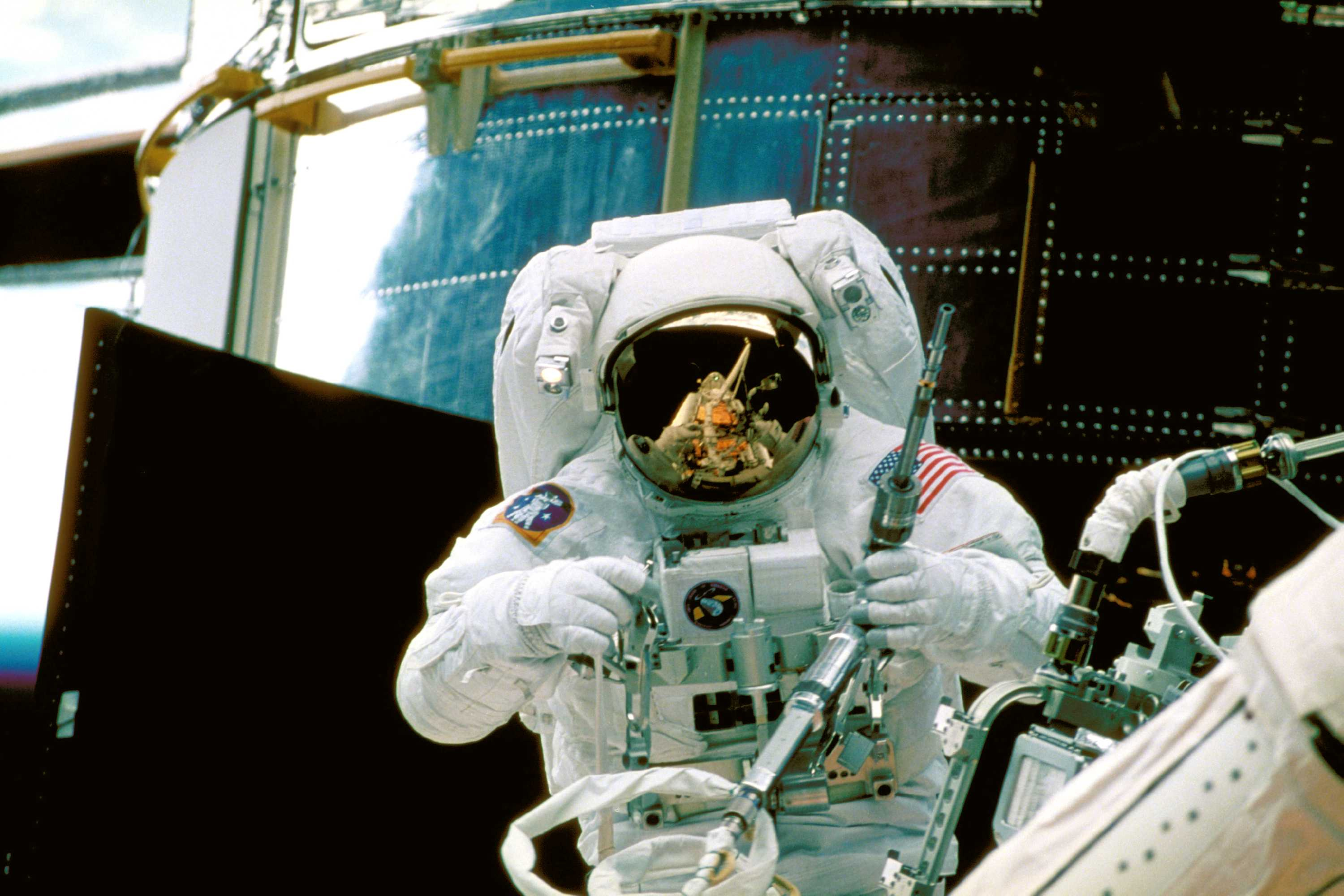
Servicing the Hubble Space Telescope – February 1997
Astronaut Steve Smith works on Hubble during STS-82, the second servicing mission in 1997, using a specially designed tool that can withstand the harsh environment of space. Hubble was specifically built to be serviced in orbit with replaceable parts and instruments.

Assembling the International Space Station – December 1998
Astronaut James H. Newman waves during a spacewalk preparing for release of the first combined elements of the International Space Station. The Russian-built Zarya module, with its solar array panel visible here, was launched into orbit fifteen years ago on Nov. 20, 1998. Two weeks later, on Dec. 4, 1998, NASA’s space shuttle Endeavour launched Unity, the first U.S. piece of the complex. Endeavour’s forward section is reflected in Newman’s helmet visor in this image. During three spacewalks on the STS-88 mission, the two space modules built on opposite sides of the planet were joined together in space, making the space station truly international.
Since that first meeting of Zarya and Unity, the space station grew piece by piece with additions from each of the international partners built across three continents and leading to the largest and most complex spacecraft ever constructed. The space station, now four times larger than Mir and five times larger than Skylab, represents a collaboration between NASA, Roscosmos, the European Space Agency, the Japanese Aerospace Exploration Agency and the Canadian Space Agency, representing 15 countries in all.
In support of station assembly and maintenance, station and shuttle crews have conducted 174 spacewalks totaling almost 1,100 hours – the equivalent to nearly 46 days of spacewalks to build and maintain the complex. The station, with a mass of almost a million pounds and the size of a football field, is second only to the moon as the brightest object in the night sky.
Over the years, a great deal of research has been done on the space laboratory, which has already yielded tremendous results toward various fields. The science of the space station has provided benefits to humankind in areas such as human health, Earth observation and education. Many more results and benefits for both space exploration and life on Earth are expected in the coming years.
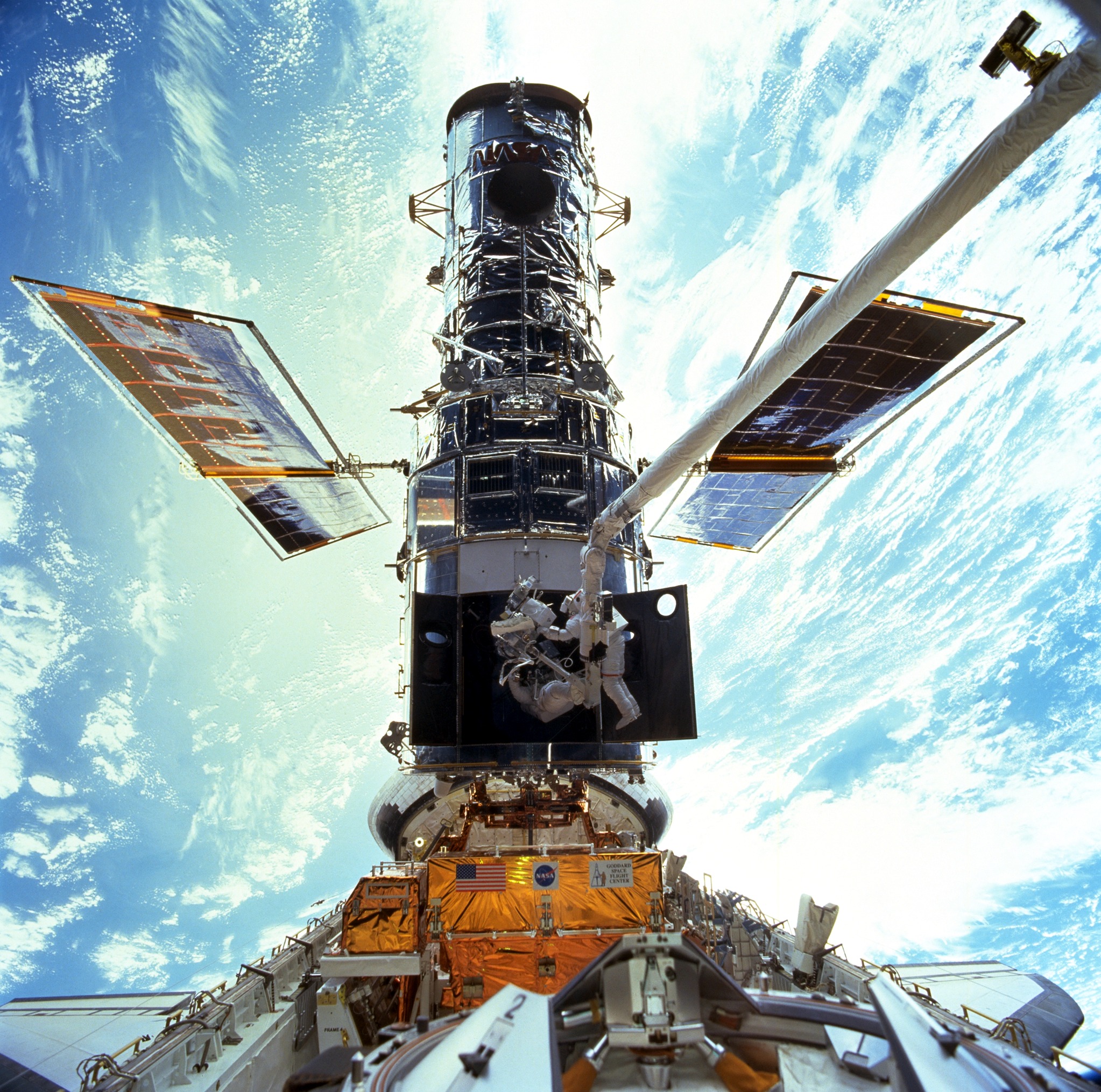
Hubble Space Telescope gets an upgrade – December 1999
Astronauts Steven L. Smith and John M. Grunsfeld are photographed during an extravehicular activity (EVA) during the December 1999 Hubble servicing mission of STS-103, flown by Discovery. On this spacewalk, the astronauts are replacing gyroscopes, contained in rate sensor units (RSU) inside the Hubble Space Telescope. NASA’s Marshall Space Flight Center in Huntsville, Ala. was responsible for the design, development, and construction of the Hubble Space Telescope, launched on April 24, 1990. Hubble was designed with these types of on orbit servicing missions in mind as a way of extending the telescope’s lifespan.
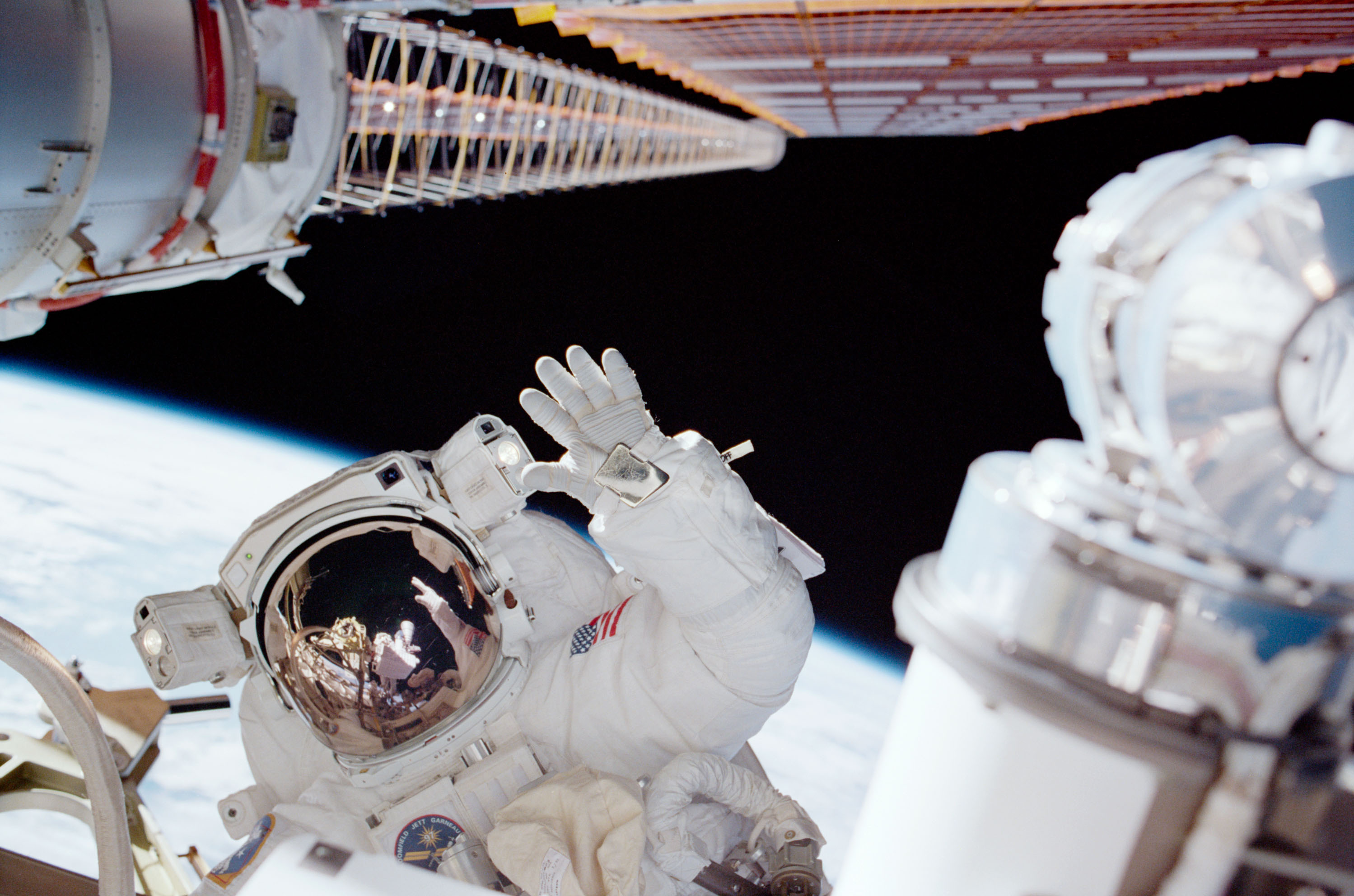
Powering up the ISS – December 2000
Astronaut Carlos I. Noriega, mission specialist, waves toward his space walk partner, astronaut Joseph R. Tanner, as Tanner snaps a 35mm frame during the second of three STS-97 sessions of extravehicular activity (EVA) on Dec. 5, 2000. Part of the newly-deployed solar array structure is at the top of the frame.
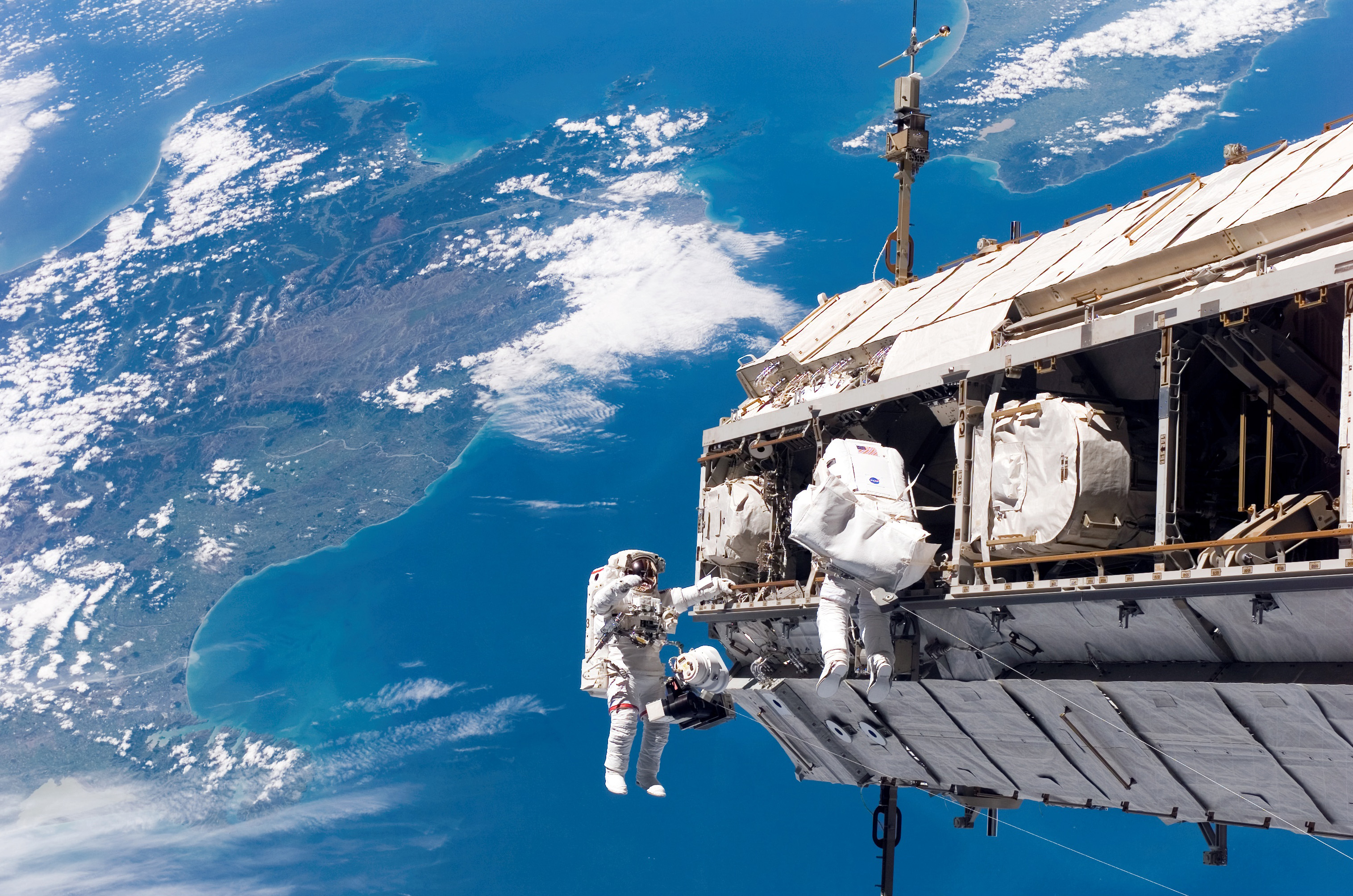
Shuttle spacewalkers work outside space station – December 2006
Backdropped by New Zealand and Cook Strait in the Pacific Ocean, astronaut Robert L. Curbeam Jr. (left) and European Space Agency (ESA) astronaut Christer Fuglesang, both STS-116 mission specialists, participate in the mission’s first of three planned sessions of extravehicular activity (EVA) as construction continues on the International Space Station. Cook Strait divides New Zealand’s North and South Islands.
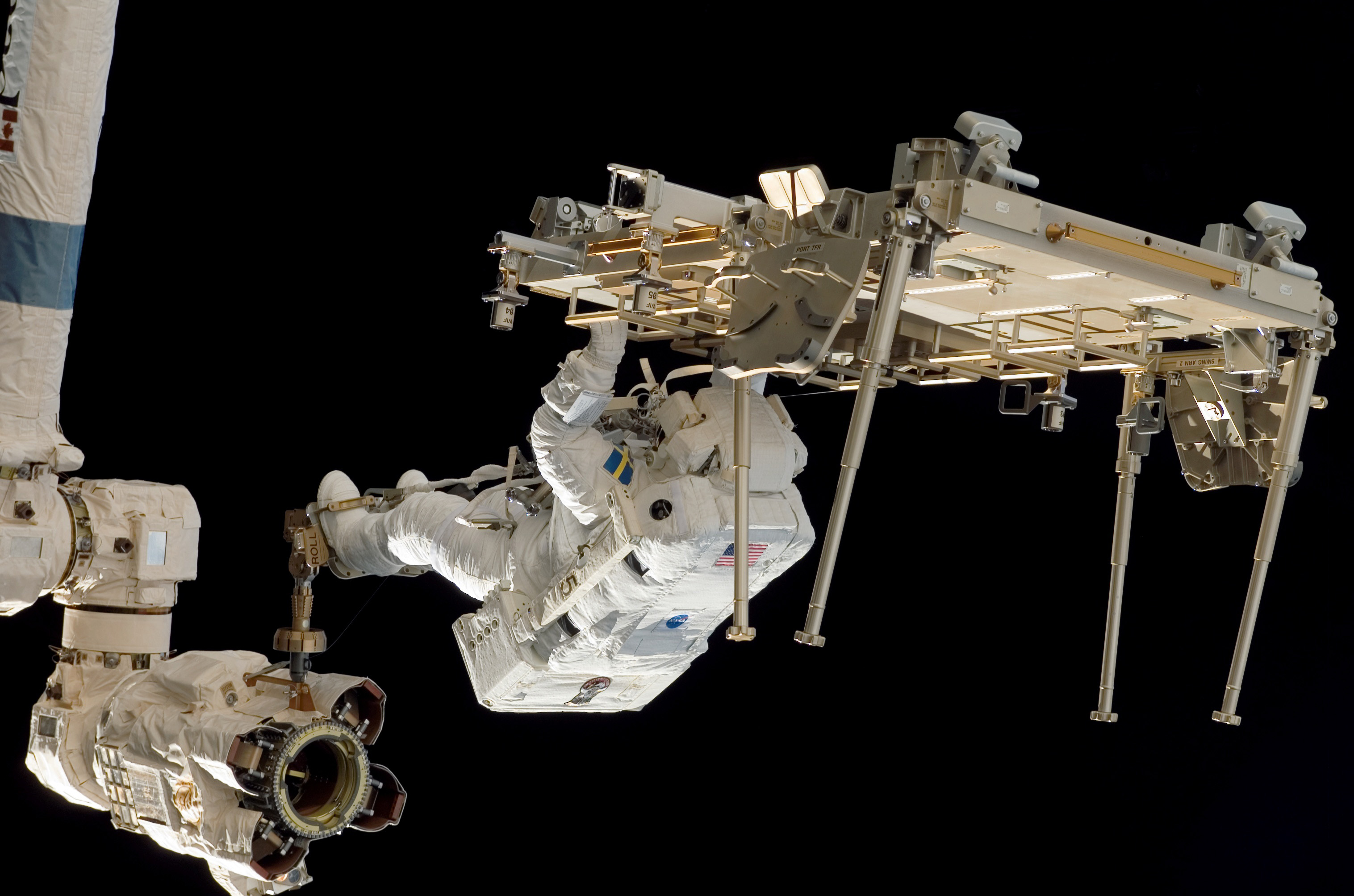
Taking a ride on the Canadarm2 – December 2006
With his feet secured on the Canadarm2, European Space Agency astronaut Christer Fuglesang, an STS-116 mission specialist, works to relocate one of the two Crew Equipment Translation Aid (CETA) carts during the second spacewalk on Dec. 14, 2006.
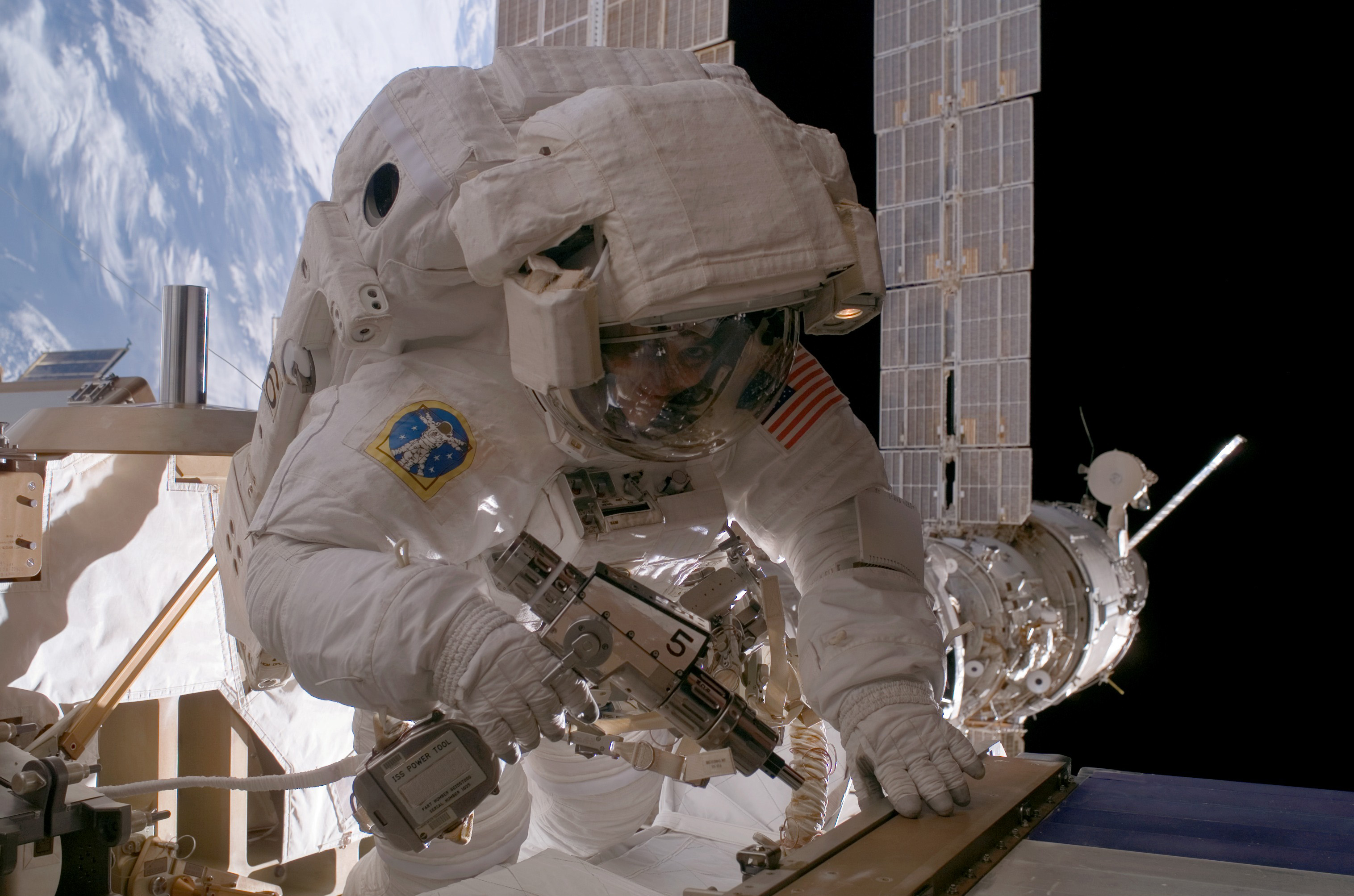
Reconfiguring the space station – January 2007
Astronaut Sunita L. Williams, Expedition 14 flight engineer, used a pistol grip tool as she worked on the International Space Station in the first of three spacewalks slated to occur over a nine-day period. During the 7-hour 55-minute spacewalk that took place on Jan. 31, 2007, Williams and station commander Michael E. Lopez-Alegria (out of frame) reconfigured one of two cooling loops for the Destiny laboratory module, rearranged electrical connections and secured the starboard radiator of the P6 truss after retraction.
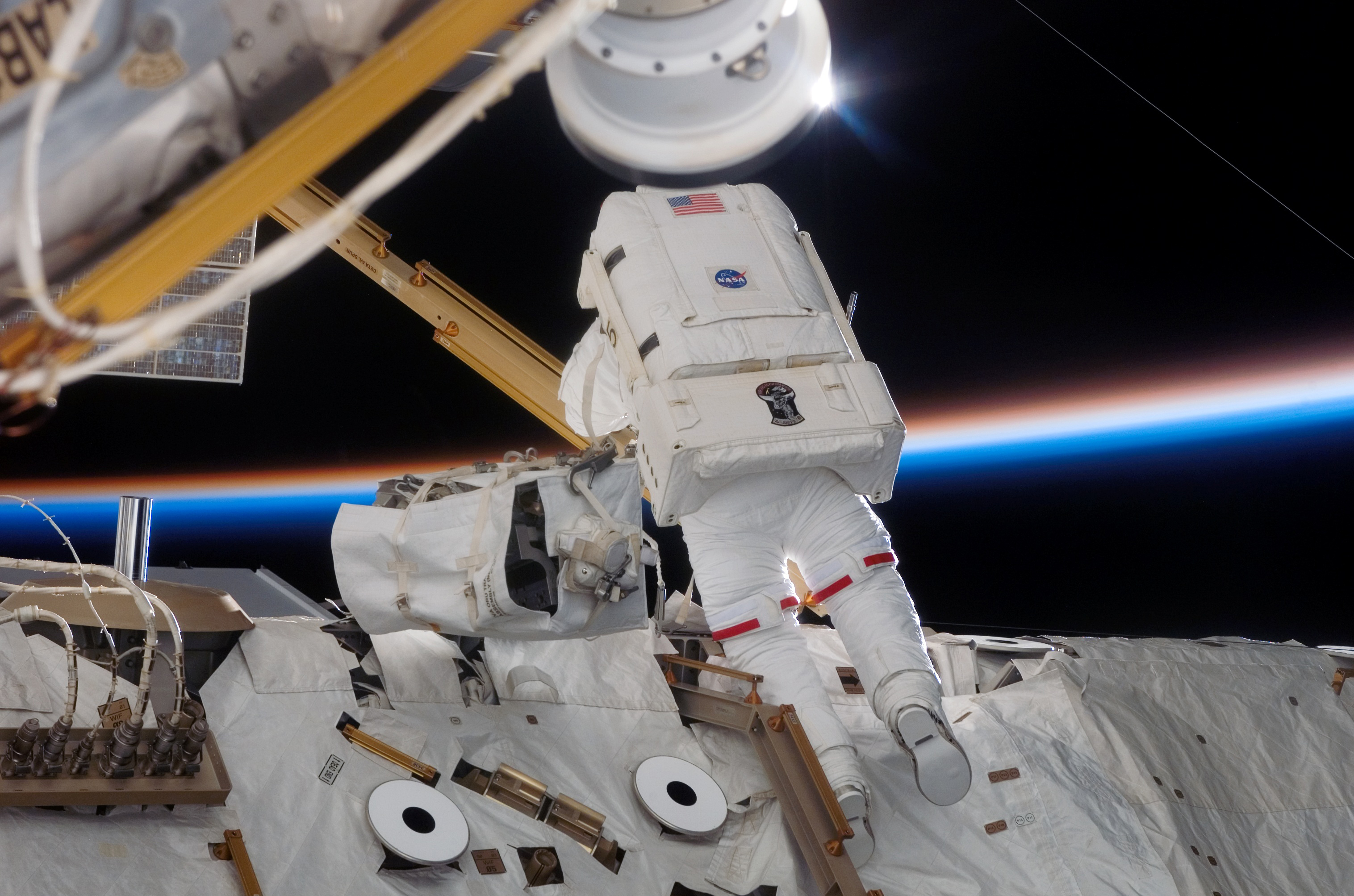
Adding more juice to the ISS – June 2007
Astronaut Jim Reilly, an STS-117 mission specialist, participated in the mission’s first planned session of extravehicular activity (EVA), as construction resumes on the International Space Station. Among other tasks, Reilly and fellow mission specialist John “Danny” Olivas connected power, data and cooling cables between S1 and S3. They also released the launch restraints from, and deployed the four solar array blanket boxes on S4, and released the cinches and winches holding the photo voltaic radiator on S4. Earth’s horizon and the blackness of space provided the backdrop for the scene.
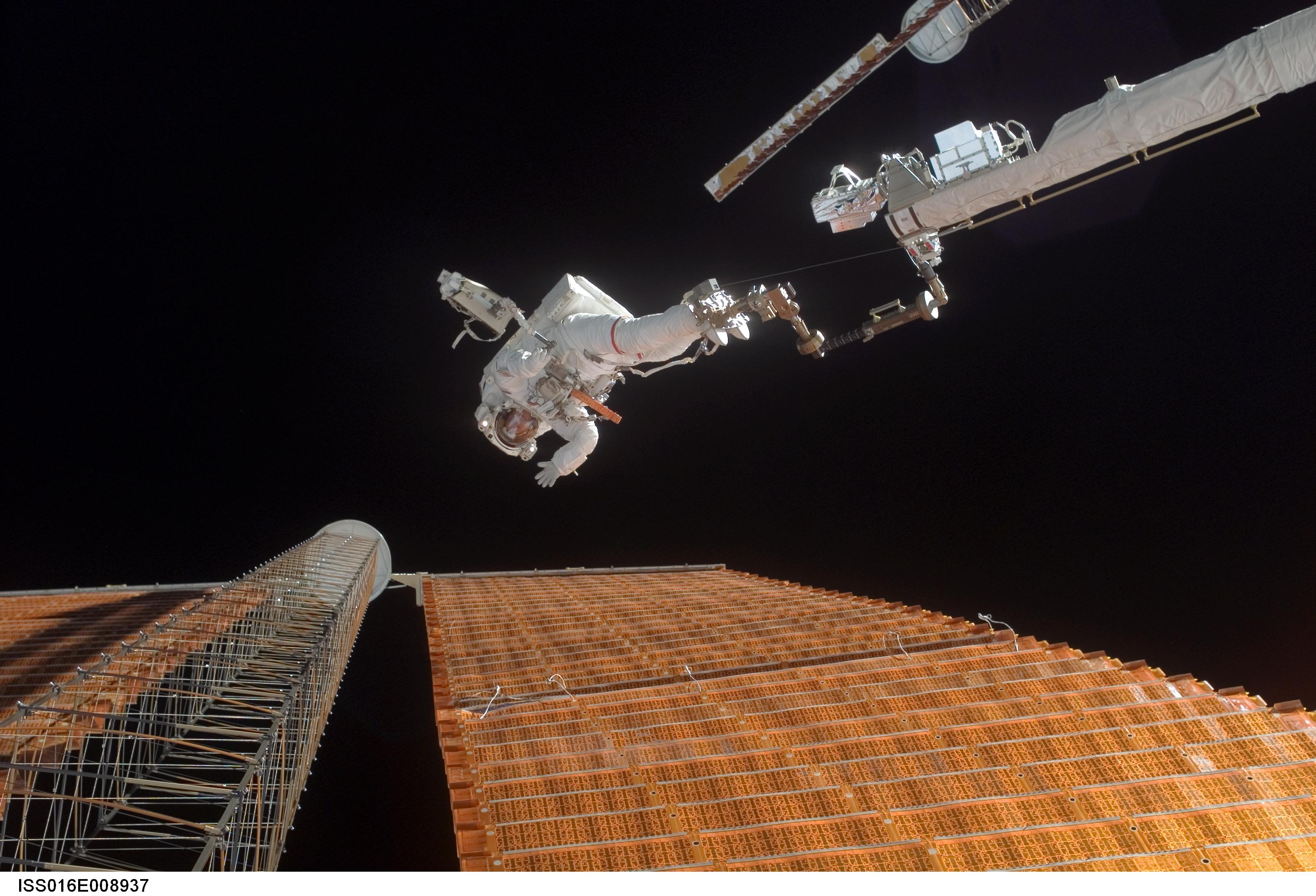
Dangerous maneuvers – November 2007
While anchored to a foot restraint on the end of the Orbiter Boom Sensor System, astronaut Scott Parazynski assesses his repair work as the solar array is fully deployed during the STS-120 mission’s fourth spacewalk on Nov. 3, 2007 while Space Shuttle Discovery is docked with the International Space Station. During the 7-hour, 19-minute spacewalk, Parazynski cut a snagged wire and installed improvised stabilizers designed to strengthen the damaged solar array’s structure and stability in the vicinity of the damage.

Reentering the safety of the airlock – May 2011
Astronaut Andrew Feustel reenters the space station after completing an 8-hour, 7-minute spacewalk at 10:12 a.m. EDT Sunday, May 22, 2011. He and fellow spacewalker Mike Fincke completed this, the second of the four STS-134 spacewalks, for a mission total of 14 hours 26 minutes. It was the 246th spacewalk conducted by U.S. astronauts, the 116th from space station airlocks, and the 157th in support of space station assembly and maintenance. It was Feustel’s fifth spacewalk and Fincke’s seventh spacewalk.
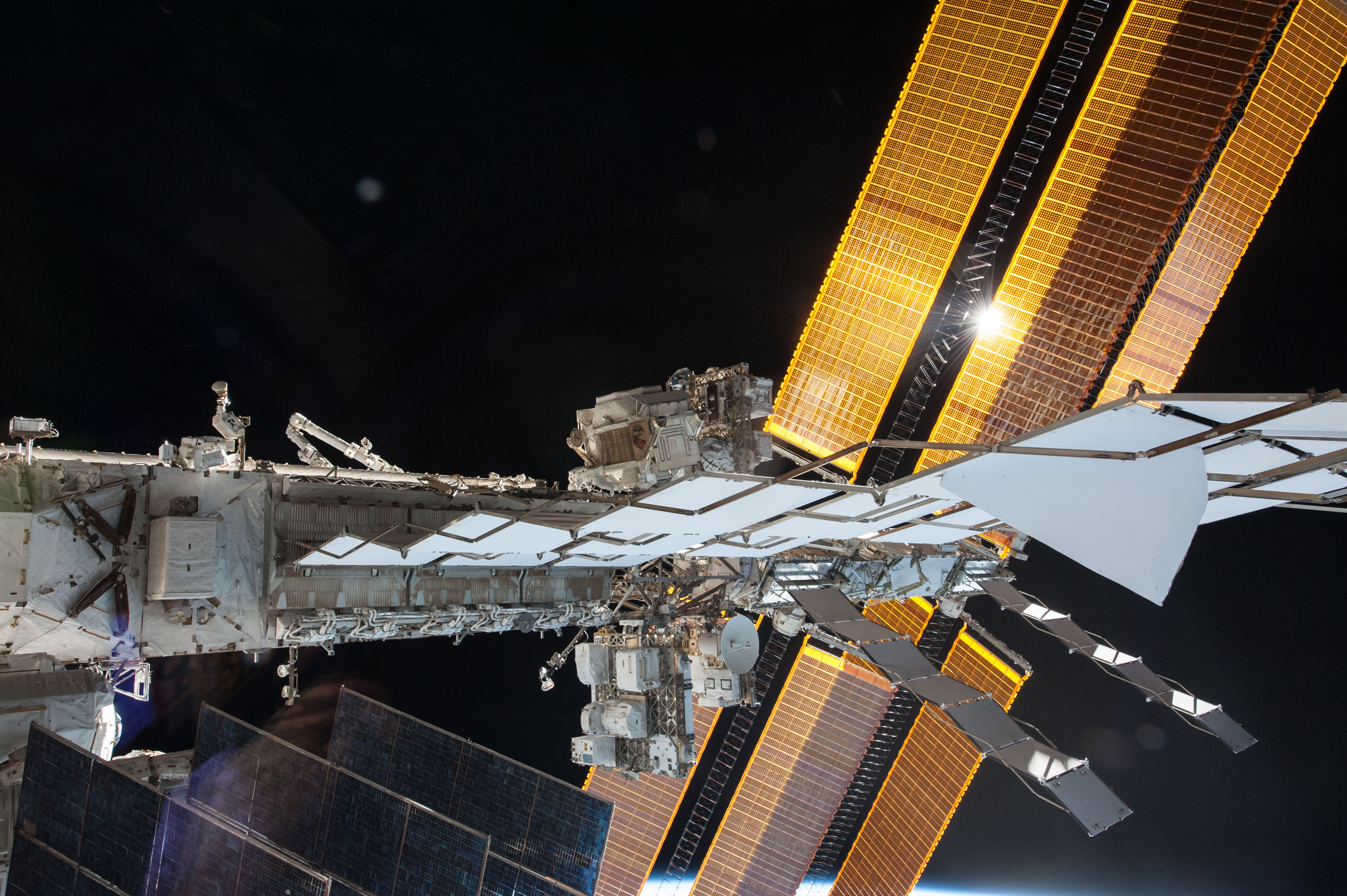
Can you spot the spacewalker? – March 2015
U.S. astronaut Terry Virts tweeted this image on Mar. 1, 2015, and asked this question: “Can you spot the space walker in this picture? He’s very small compared to the enormous starboard truss of the #ISS.” Terry is a flight engineer on the International Space Station.
Head on over to http://www.nasa.gov/suitup/spacewalks to view additional spacewalking images from the past 50 years of NASA history.

